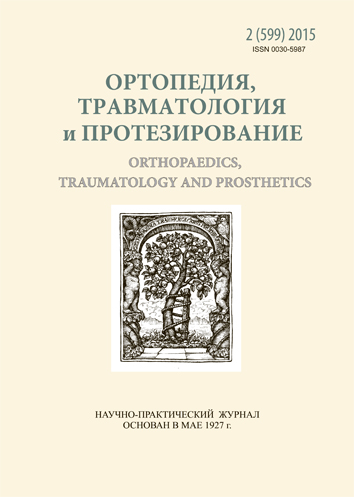Treatment of «unhappy triad of the elbow» and its consequences
DOI:
https://doi.org/10.15674/0030-59872015242-47Keywords:
dislocation of forearm, elbow joint injury, fracture of the radial head, fracture of the coronoid process of the ulnaAbstract
Despite on the development of treatments for intra-articular damages the recovery of function after severe injuries of the elbow is complicated problem and is far from a solution. Objective: To develop a differentiated tactics of treatment for patients with the «unhappy triad of the elbow» depending on timing of the damage, its character and associated injuries. Methods: Outcomes in 27 patients (14 men, 13 women aged 17 to 66 years) with the «unhappy triad of the elbow» were analyzed. In 11 cases (41 %) there was damage to the right upper extremity, in16 patients (59 %) the left elbow was injured. The period of follow-up ranged from 3 to 120 months. Long-term results of treatment were evaluated in 22 patients out of 27 ones according to a scale of Mayo Elbow Performance Score (MEPS). Results of treatment in patients with «unhappy triad» depend on the severity and character of the injuries and character of previous surgery. According to MEPS in operated patients with «unhappy triad of the elbow» there were achieved excellent results in 5 cases (23 %), good — in 10 (45 %), satisfactory – in 5 (23 %), and poor — in 2 (9 % ) ones. Conclusion: «unhappy triad» is a serious injury of the elbow which requires the full restoration of all damaged structures with a dosed postoperative rehabilitation in early terms after injury. Saving the radial head and the coronoid process of the ulna are pledge of restoration of full function of the elbow joint. With the combination of «unhappy triad of the elbow» with the Essex-Lopresti injury except for reconstructive surgery on the elbow it is necessary to carry out corrective surgeries in order to eliminate radiation talipomanus and conflicts developing in the distal radioulnar articulation.References
- Bucholz R. W. Rockwood and Green’s fractures in adults / R. W. Bucholz, J. D. Heckman, C. M. Court-Brown et al. — 6th ed. — Lippincott Williams & Wilkins, 2006. — 2340 p.
- McKay P. L. Fracture of the proximal ulna olecranon and coronoid fractures / P. L. McKay, J. A. Katarincic // Hand Clin. — 2002. — Vol. 18. — P. 43–53.
- Morrey B. F. The elbow and its disorders / B. F. Morrey. — 4th ed. — Saunders Elsevier, 2009. — 1232 p.
- Regan W. Classification and treatment of coronoid process fractures / W. Regan, B. F. Morrey // Orthopedics. — 1992. — Vol. 15. — P. 845–848.
- Ring D. Posterior dislocation of the elbow with fractures of the radial head and coronoid / D. Ring, J. B. Jupiter, J. Zilberfarb // J. Bone Joint Surg. Am. — 2002. — Vol. 84. — P. 547–551.
- Standard surgical protocol to treat elbow dislocations with radial head and coronoid fractures / D. M. Pugh, L. M. Wild, E. H. Schemitsch [et al.] // J. Bone Joint Surg. Am. — 2004. — Vol. 86. — P. 1122–1130.
- Stanely D. Operative elbow surgery / D. Stanely, I. A. Trail. — Churchill Livingstone Elsevier, 2012. — 791 p.
- Terrible triad of the elbow / R. Seijas, O. Ares-Rodriguez, A. Orellana [et al.] // J. Orthop. Surg. (Hong Kong). — 2009. — Vol. 17 (3). — P. 335–339.
- Williams G. R. Operative techniques in shoulder and elbow surgery / G. R. Williams, M. L. Ramsey, S. W. Wiesel. — Lip¬pincott Williams & Wilkins, 2011. — 425 p.
Downloads
How to Cite
Issue
Section
License
Copyright (c) 2015 Igor Kurinnyi, Sergey Strafun

This work is licensed under a Creative Commons Attribution 4.0 International License.
The authors retain the right of authorship of their manuscript and pass the journal the right of the first publication of this article, which automatically become available from the date of publication under the terms of Creative Commons Attribution License, which allows others to freely distribute the published manuscript with mandatory linking to authors of the original research and the first publication of this one in this journal.
Authors have the right to enter into a separate supplemental agreement on the additional non-exclusive distribution of manuscript in the form in which it was published by the journal (i.e. to put work in electronic storage of an institution or publish as a part of the book) while maintaining the reference to the first publication of the manuscript in this journal.
The editorial policy of the journal allows authors and encourages manuscript accommodation online (i.e. in storage of an institution or on the personal websites) as before submission of the manuscript to the editorial office, and during its editorial processing because it contributes to productive scientific discussion and positively affects the efficiency and dynamics of the published manuscript citation (see The Effect of Open Access).














